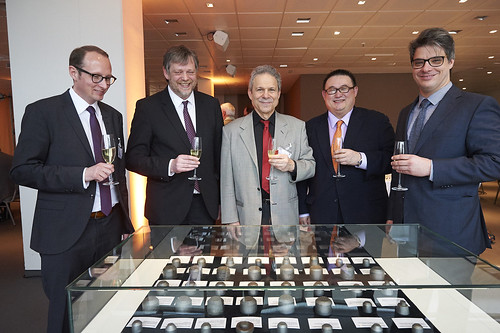
PREV ARTICLE
NEXT ARTICLE
FULL ISSUE
PREV FULL ISSUE
NEW EXHIBIT TO FEATURE COIN DIES FROM CHINABjörn Schöpe writes: In June of 2012 Künker Auction 211 offered Chinese dies and punches. They originated from the archives of the Otto Beh company from Esslingen and are witnesses to the beginning of modern Chinese numismatics. The patterns of these dies belong to the most sought after rarities of Chinese numismatics. Aiming at the preservation of cultural property international trade, the owner of the objects, academics, and museums collaborated in order to integrate these objects into the permanent exhibit of the coin cabinet Moritzburg of Halle.
Björn provided this press release about the new exhibit. Thanks! -Editor

The delivery of the dies to the Foundation of Domes and Castles of Saxony-Anhalt was celebrated by many. From l. to r.: Ulrich Künker, Managing Director of Fritz Rudolf Künker GmbH & Co KG, Ulf Dräger, director of the state coin cabinet Moritzburg, Robert Mish, President of Mish International USA, Michael Chou, Owner of Champion Auction, Hong Kong-Taipei-Shanghai, Dr Christian Philipsen, president of the Foundation of Domes and Castles of Saxony-Anhalt. This is a story about globalization, long before the word even existed. It’s a story about German technology, Chinese coinage and about the cooperation between the numismatic trade, collectors, academics, and museums. But let’s start at the beginning: In June of 2012 lot no. 2528 of Künker Auction 211 offered Chinese dies and punches. They originated from the archives of the Otto Beh company from Esslingen. In a Festschrift, to commemorate the 125th anniversary of this company, they had been written about in German only - which might have been the reason they weren’t getting any international attention. The Künker Auction catalog 211 on the other hand, was also being read in China and what experts found, provoked a substantial discussion. What one needs to know: the patterns of these dies belong to the most sought after rarities of Chinese numismatics. In auctions they reach results in the six digit region, partly because of the scholarly mystery which surrounded them in terms of where they had been produced. The find of the dies answered this question. The patterns from the dies of the company of Otto Beh are witnesses to the beginning of modern Chinese numismatics, when, in the course of modernization of the country, western means of payments were introduced. In this context, coin presses from the best known companies were ordered: from Philadelphia, Birmingham and of course, Germany. The German company Schuler delivered its first friction presses to China in 1895. And the first dies for those machines were commissioned to the engraving company of Otto Beh, located in Esslingen. He produced over 40 dies for Schuler. In 1898 and 1899 Beh received a second order from a merchant of the city of Magdeburg. All in all the Otto Beh company produced more than 200 dies for Chinese mints, which partially - this is the time shortly before the Boxer rebellion - never opened. On the one hand this made the dies offered by Künker a high-level document of Chinese-German numismatic and economic history. On the other hand, they could have potentially been misused by criminals to produce counterfeits. And this is the reason Michael Chou, owner of Champion auction house of Hong Kong, contacted Künker to not publicly auction these objects off. It did not take long to convince the owner to withdraw the lot and with the help of a micro engraving, the dies were rendered useless for producing exact copies of the in demand patterns. For a long time, both Künker and Michael Chou were looking for a museum in China or Germany, who would make these precious pieces available for the public. On the condition to integrate the dies in a permanent exhibit, the coin cabinet Moritzburg of Halle was chosen to give a home to these valuable artifacts. And it certainly is the right place, already giving a home to the second largest collection of Chinese coins in Germany. Together with the early modern Stolberg mint, also cared for by the coin cabinet, the history of coin producing presents the main research focus of Ulf Dräger, director of the state coin cabinet at the Moritzburg gallery. He himself and Dr Christian Philipsen, president of the Foundation of Domes and Castles of Saxony-Anhalt, came to Berlin to receive the precious donation during a celebratory ceremony at the World Money Fair. Auction house Künker was presented by Ulrich Künker and Dr Andreas Kaiser. Michael Chou embraced the chance to personally say a few words to all attendees. But it was Ulrich Künker, who best summarized the core message of this event: “What we do here is lived protection of culture. We all carry the responsibility for the important documents of our past. This celebratory ceremony today at the World Money Fair was only possible because of the collaboration of the international trade, the owner of the objects, academics, and museums. And it happened in a pragmatic and friendly atmosphere, which was about finding a solution and making everybody a winner.” Starting on September 17th, 2016, as part of a special exhibit about Chinese coinage, the dies will be presented to the public at Moritzburg. Wayne Homren, Editor The Numismatic Bibliomania Society is a non-profit organization promoting numismatic literature. See our web site at coinbooks.org. To submit items for publication in The E-Sylum, write to the Editor at this address: whomren@gmail.com To subscribe go to: https://my.binhost.com/lists/listinfo/esylum All Rights Reserved. NBS Home Page Contact the NBS webmaster 
|